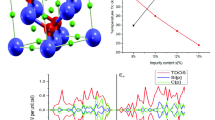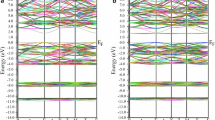Abstract
Magnetism induced by the nonmagnetic dopants in the zinc-blende SiC (3C-SiC) is investigated by first-principle calculations. The atoms of the first 20 elements in the periodic table except inert gas are used to replace either Si or C atoms as dopants. We find that some nonmagnetic substitutional dopants (mainly the Group IA, Group IIA, Group IIIB, and Group VIIB elements) prefer the spin-polarized ground states with local magnetic moments. In general, the condition for obtaining the local magnetic moments and the magnetic ground state requires that the dopants are p-type and have large electronegativity difference from the neighboring host atoms. The magnetic moments can be tuned over a range between 1 µ B and 3 µ B by doping with the nonmagnetic elements. The nearest-neighbor exchange couplings J 0 between the local magnetic moments are quite large and the codoping method is proposed to increase the dopant concentration. These imply that the nonmagnetic doping in SiC may exhibit collective magnetism. Moreover, the Group IIA Mg and Ca atoms substituting the preferred Si atoms favor the ferromagnetic ground states with the half-metallic electronic properties, which suggests that Mg or Ca substitutional doping on the Si sites in SiC could be a potential route to fabricating the diluted magnetic semiconductors.
Similar content being viewed by others
References
Fiederling R, Keim M, Reuscher G, et al. Injection and detection of a spin-polarized current in a light-emitting diode. Nature, 1999, 402: 787–790
Ohno Y, Young D K, Beschoten B, et al. Electrical spin injection in a ferromagnetic semiconductor heterostructure. Nature, 1999, 402: 790–792
Wolf S A, Awschalom D D, Buhrman R A, et al. Spintronics: A spinbased electronics vision for the future. Science, 2001, 294: 1488–1495
Dietl T, Ohno H, Matsukura F, et al. Zener model description of ferromagnetism in zinc-blende magnetic semiconductors. Science, 2000, 287: 1019–1022
Dietl T, Ohno H, Matsukura F. Hole-mediated ferromagnetism in tetrahedrally coordinated semiconductors. Phys Rev B, 2001, 63: 195205
Pearton S J, Norton D P, Ip K, et al. Recent advances in processing of ZnO. J Vac Sci Technol B, 2004, 22: 932–948
Venkatesan M, Fitzgerald C B, Lunney J G, et al. Anisotropic ferromagnetism in substituted zinc oxide. Phys Rev Lett, 2004, 93: 177206
Yoon S D, Chen Y, Don H, et al. Room temperature magnetism in semiconducting films of ZnO doped with ferric ions. J Appl Phys, 2006, 99: 08M109
Liu H X, Wu S Y, Singh R K, et al. Observation of ferromagnetism above 900 K in Cr-GaN and Cr-AlN. Appl Phys Lett, 2004, 85: 4076–4078
Lin H, Duan H M. Local electronic structure and magnetic properties of 3d transition metal doped GaAs. Sci China Ser G-Phys Mech Astron, 2008, 51: 470–480
MacDonald A H, Schiffer P, Samarth N. Ferromagnetic semiconductors: Moving beyond (Ga,Mn)As. Nat Mater, 2005, 4: 195–202
Theodoropoulou N, Hebard A F, Chu S N G, et al. Magnetic and structural properties of Fe, Ni, and Mn-implanted SiC. J Vac Sci Technol A, 2002, 20: 579–582
Stromberg F, Keune W, Chen X, et al. The origin of ferromagnetism in 57Fe ion-implanted semiconducting 6H-polytype silicon carbide. J Phys-Condens Matter, 2006, 18: 9881–9900
Matsumoto Y, Murakami M, Shono T, et al. Room-temperature ferromagnetism in transparent transition metal-doped titanium dioxide. Science, 2001, 291: 854–856
Hou X G, Huang M D, Wu X L, et al. First-principles calculations on implanted TiO2 by 3d transition metal ions. Sci China Ser G-Phys Mech Astron, 2009, 52: 838–842
Feng X. Electronic structures and ferromagnetism of Cu- and Mn-doped ZnO. J Phys-Condens Matter, 2004, 16: 4251–4259
Ye L H, Freeman A J, Delley B. Half-metallic ferromagnetism in Cudoped ZnO: Density functional calculations. Phys Rev B, 2006, 73: 033203
Huang L M, Rosa A L, Ahuja R. Ferromagnetism in Cu-doped ZnO from first-principles theory. Phys Rev B, 2006, 74: 075206
Buchholz D B, Chang R P H, Song J H, et al. Room-temperature ferromagnetism in Cu-doped ZnO thin films. Appl Phys Lett, 2005, 87: 082504
Hou D L, Ye X J, Meng H J, et al. Magnetic properties of n-type Cudoped ZnO thin films. Appl Phys Lett, 2007, 90: 142502
Lee J H, Choi I H, Shin S, et al. Room-temperature ferromagnetism of Cu-implanted GaN. Appl Phys Lett, 2007, 90: 032504
Wu R Q, Peng GW, Liu L, et al. Cu-doped GaN: A dilute magnetic semiconductor from first-principles study. Appl Phys Lett, 2006, 89: 062505
Jia W, Han P, Chi M, et al. Electronic structure and ferromagnetic properties of Cu-doped AlN from first principles. J Appl Phys, 2007, 101: 113918
Fan S W, Yao K L, Liu Z L, et al. Ferromagnetic properties, electronic structure, and formation energy of Ga0.9375M0.0625N (M= vacancy, Ca) by first principles study. J Appl Phys, 2008, 104: 043912
Osuch K, Lombardi E B, Adamowicz L. Palladium in GaN: A 4d metal ordering ferromagnetically in a semiconductor. Phys Rev B, 2005, 71: 165213
Wu R Q, Peng GW, Liu L, et al. Ferromagnetism in Mg-doped AlN from ab initio study. Appl Phys Lett, 2006, 89: 142501
Pan H, Yi J B, Shen L, et al. Room-temperature ferromagnetism in carbon-doped ZnO. Phys Rev Lett, 2007, 99: 127201
Yu C F, Lin T J, Sun S J, et al. Origin of ferromagnetism in nitrogen embedded ZnO: N thin films. J Phys D, 2007, 40: 6497–6500
Shen L, Wu R Q, Pan H, et al. Mechanism of ferromagnetism in nitrogen-doped ZnO: First-principle calculations. Phys Rev B, 2008, 78: 073306
Kenmochi K, Seike M, Sato K, et al. New class of diluted ferromagnetic semiconductors based on CaO without transition metal elements. Jpn J Appl Phys, 2004, 43: L934–L936
Elfimov I S, Rusydi A, Csiszar S I, et al. Magnetizing oxides by substituting nitrogen for oxygen. Phys Rev Lett, 2007, 98: 137202
Song B, Bao H Q, Li H, et al. Observation of glassy ferromagnetism in Al-doped 4H-SiC. J Am Chem Soc, 2009, 131: 1376–1377
Kresse G, Hafner J. Ab initio molecular dynamics for liquid metals. Phys Rev B, 1993, 47: 558–561; Ab initio molecular-dynamics simulation of the liquid-metal-amorphous-semiconductor transition in germanium. Phys Rev B, 1994, 49: 14251–14269; Kresse G, Furthmüller J. Efficiency of ab-initio total energy calculations for metals and semiconductors using a plane-wave basis set. Comput Mater Sci, 1996, 6: 15–50; Efficient iterative schemes for ab initio total-energy calculations using a plane-wave basis set. Phys Rev B, 1996, 54: 11169–11186
Kresse G, Joubert D. From ultrasoft pseudopotentials to the projector augmented-wave method. Phys Rev B, 1999, 59: 1758–1775
Perdew J P, Burke K, Ernzerhof M. Generalized gradient approximation made simple. Phys Rev Lett, 1996, 77: 3865–3868
Zywietz A, Furthmüller J, Bechstedt F. Vacancies in SiC: Influence of Jahn-Teller distortions, spin effects, and crystal structure. Phys Rev B, 1999, 59: 15166–15180
Dev P, Xue Y, Zhang P. Defect-induced intrinsic magnetism in wide-gap III nitrides. Phys Rev Lett, 2008, 100: 117204
Zhang S B, Wei S H, Zunger A. Overcoming doping bottlenecks in semiconductors and wide-gap materials. Physica B, 1999, 273–274: 976–980
Yamamoto T. Codoping method for solutions of doping problems in wide-band-gap semiconductors. Phys Stat Sol (a), 2002, 193: 423–433
Neugebauer J, Van de Walle C G. Role of hydrogen in doping of GaN. Appl Phys Lett, 1996, 68: 1829–1831
Han B, Gregie J M, Wessels B W. Blue emission band in compensated GaN:Mg codoped with Si. Phys Rev B, 2003, 68: 045205
Korotkov R Y, Gregie J M, Wessels B W. Electrical properties of p-type GaN: Mg codoped with oxygen. Appl Phys Lett, 2001, 78: 222–224
Brandt O, Yang H, Kostial H, et al. High p-type conductivity in cubic GaN/GaAs(113)A by using Be as the acceptor and O as the codopant. Appl Phys Lett, 1996, 69: 2707–2709
Katayama-Yoshida H, Nishimatsu T, Yamamoto T, et al. Codoping method for the fabrication of low-resistivity wide band-gap semiconductors in p-type GaN, p-type AlN and n-type diamond: Prediction versus experiment. J Phys-Condens Matter, 2001, 13: 8901–8914
Tsukazaki A, Saito H, Tamura K, et al. Systematic examination of carrier polarity in composition spread ZnO thin films codoped with Ga and N. Appl Phys Lett, 2002, 81: 235–237
Yamamoto T, Kishimoto S, Iida S. Materials design for p-type ZnS with blue Ag emission by triple-codoping method. Phys Stat Sol (b), 2002, 229: 371–375
Mueller D C, Fichtner W. Codoping as a measure against donor deactivation in Si: Ab initio calculations. Phys Rev B, 2006, 73: 035210
Aradi B, Gali A, Deák P, et al. Ab initio density-functional supercell calculations of hydrogen defects in cubic SiC. Phys Rev B, 2001, 63: 245202
Gali A, Heringer D, Deák P, et al. Isolated oxygen defects in 3C- and 4H-SiC: A theoretical study. Phys Rev B, 2002, 66: 125208
Rurali R, Godignon P, Rebollo J, et al. First-principles study of n-type dopants and their clustering in SiC. Appl Phys Lett, 2003, 82: 4298–4300 doi: 10.1007/s11433-010-0107-0
Author information
Authors and Affiliations
Corresponding author
Additional information
Recommended by LONG GuiLu
Rights and permissions
About this article
Cite this article
Liu, Z., Ni, J. Magnetism induced by nonmagnetic dopants in zinc-blende SiC: First-principle calculations. Sci. China Phys. Mech. Astron. 53, 1–10 (2010). https://doi.org/10.1007/s11433-010-0085-2
Received:
Accepted:
Published:
Issue Date:
DOI: https://doi.org/10.1007/s11433-010-0085-2




